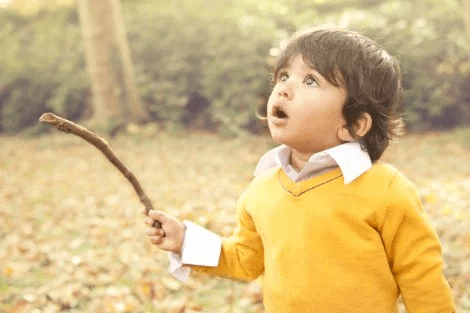Educating in Astonishment: A Positive Aspect

We’re exposed to numerous stimuli, and even if it’s contradictory, we’re losing the capacity of feeling astonished. In this article we’ll talk about how educating children in astonishment is something positive to keep making them feel surprised and leave them wanting to know and learn more about the world that surrounds them.
Educating in astonishment means carefully learning to observe everyone and everything that surrounds us and reflect on it. We live at a fast pace and we’re permanently in contact with technology and noise. We have a lot to do, see, and buy. But, many times, none of this surprises us.
What is astonishment and how does an astonished person react?
Astonishment is related to surprise, amazement, and consternation due to something unexpected or unintended. It’s the impression that something or someone makes on a person’s mood due to a special or exceptional quality.
So, when we talk about an astonished person, we refer to their capacity for astonishment. It’s an ability that people can develop and that allows them to let themselves be surprised and learn from it. This makes us doubt and ask questions. It leads us to think and reflect.

Educating in astonishment: teaching to allow surprise
For a child, astonishment is the driving force of their motivation. But although they show surprise at any stimulus, object, or close person, you must be careful with overstimulation. This is because overstimulation can replace the driving force, destroying their sense of astonishment as well as their imagination and creativity.
As we grow we lose our capacity for being astonished. It’s important to practice this at home and at school. As we’ve said, astonishment is essential to develop the capacity for reflection and introspection.
Catherine L’Ecuyer, in her book Educar en el Asombro ( Educating in Astonishment) (2013), talks about achieving this so that children and teenagers don’t lose this capacity or the motivation and enthusiasm for discovery.
She also talks about the need to reconsider learning and treat it as a journey from the inside out. The author mentions that instead of pushing children to reach a certain stage quickly, teachers and parents must respect their pace and nature.
Indeed, the nature of children is their innocence and their need for astonishment. This becomes interrupted by a frenetic and more demanding environment, with more stimulus and fewer options to allow them to think at their own pace. This environment absorbs their senses and limits their imaginations, which doesn’t allow mystery and uncertainty.
“Astonishment connects us with our capacity to see the world from a child’s eyes.”
What must we consider for educating in astonishment?
Educating in astonishment involves planning school activities in which we must consider the following aspects:
- Arouse curiosity and surprise children every day. In line with the work of making children learn routines and create habits. So, any different or uncommon situation at school is perfect to educate in astonishment. For example, put on a song and invite them to dance or make them exchange their shoes for a few hours.
- Planning outdoor activities to be in contact with nature. The environment gives children infinite objects and situations that cause them to be curious. We can work on aspects such as observation and then raise questions.

- Plan uncommon activities with children. Organize a puppet show or a day for dads and moms. This will allow them to know about their parent’s jobs. Another idea is to visit a farm to learn how animals live and what they eat.
- Teach children the positive aspect of silence. Work with them in activities to learn to be calm and quiet. Encourage them to focus and pay attention to what they feel or listen to on the inside and also to hear external and uncommon noises. Because noise is something that’s constant in their lives.
- Let children be bored and play alone. Loneliness allows them to imagine and find creative ways of distraction. Also, overstimulation isn’t good because they become used to it. This makes children dependent on adults and risks hyperactivity.
Conclusion
Educating in astonishment means that parents and teachers teach children to be surprised and find something different and uncommon in every situation. Teach them to question and reflect on what they see and how to live, instead of just accepting it. This is the first step for all significant learning.
All cited sources were thoroughly reviewed by our team to ensure their quality, reliability, currency, and validity. The bibliography of this article was considered reliable and of academic or scientific accuracy.
- l’Ecuyer, C. (2013). Educar en el asombro. Editorial Plataforma. Recuperado de https://books.google.es/books?hl=es&lr=&id=CvSkDwAAQBAJ&oi=fnd&pg=PT5&dq=educar+en+el+asombro&ots=9rFgRBYAYj&sig=c-lCLfG_LVt5I9MKuMbLvXiwpC0#v=onepage&q=educar%20en%20el%20asombro&f=false
- Correa Morales, A. C. (2019). Educar en el asombro: políticas, principios y significados en el Colegio San José (Bachelor’s thesis, Universidad de La Sabana). Recuperad de https://intellectum.unisabana.edu.co/bitstream/handle/10818/36078/Correa%20Morales%2c%20Ana%20Catalina.%20Educar%20en%20el%20asombro.%20pol%c3%adticas%2c%20principios%20y%20significados%20en%20el%20Colegio%20San%20Jos%c3%a9.pdf?sequence=1&isAllowed=y
